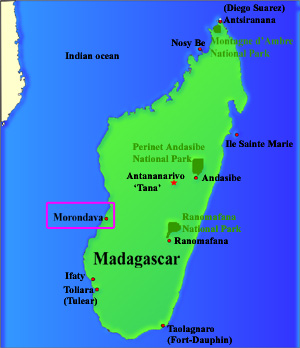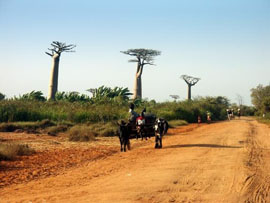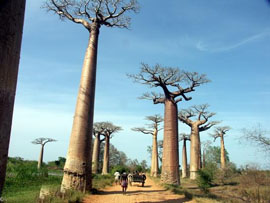Morondava Hotels and accommodation
|
Click to Search all Madagascar Accommodation
Cliquez sur recherche tous les locaux de Madagascar

Flights to Madagascar from South Africa
Madagascar Hotel GuideNorth Central Madagascar South Best Beach Destinations Rainforest and Mountain Baobabs Other Places |
Madagascar Essential
|
Travel Guide to
|
Morondava Information Guide
Morondava Two religions cohabit in Morondava: a relatively tolerant Islam
Sunnite and a rather rigid Lutherian Protestantism. They are combined
to give to the city a rather heavy atmosphere which however is attenuated
as soon as you get closer to the peripheral districts and the neighbouring
villages. Morondava shelters people with very particular customs and habits
which only belong to them. That makes this area so special and unique
in its kind. |
 |
Many royal tombs, are the subject of curiosity to tourists. It is the Sakalava funerary art which makes these tombs very attractive. For these people, the relationship between the dead and those who are alive belongs to everyday life. Among the Sakalava society, “Andriana” or kings deaths, especially, are closely related to life because that constitutes the first intermediary between the terrestrial life and the life of beyond. For this reason the worship of “tromba” or worship of possession is much venerated in this area. These tombs are mainly built out of wood. They seldom comprise tomb stone. The royal tombs always comprise crowned relics. The characteristic of these tombs is that they are decorated with frescos and funerary sculptures telling the life of the deceased ones, rather naive but often impressed of a belief of erotism, erotic statues which mean much for the Sakalava because they symbolize procreation and life. They are anyway the witnesses, depicting a population without state of heart, but full with sap and strength. |
 |
| Morondava Area telephone code Madagascar
Phone code +261 |
|
In Morondava, the sea does not cease nibbling the coasts which ended
up conceding almost two km of coast and fertile plain in one century and
half. In spite of the damage it causes, the Mozambique Channel still remains
the principal possible way for the Sakalava of Menabe to leave their den
with their sailing dugout canoes or wooden boats called goélettes.
The rhythm of life in Morondava is animated by fishing (fish, cucumber
of sea…), the culture and gathering of wild products intended for
sale such as the raffia, wood, wild honey, the block of wax locally called
“lasira”… These products constitute the currency of
exchange for daily life products people need in the “Dokany”
or “karana” or Indo-Pakistanis store”. The latter, as
in all the Western part of the Great Island, dominate the trade with Morondava.
One of tourist attractions of Morondava consisted in visiting these tombs
(and to photograph them), but it is from now on in discredit near villages
owners of the tombs because of many thieves of funerary posts made in
the past years by foreigners without scruples just eager to bring back
authentic and negotiable memories for various European or American museums
and private collectors. The various tombs which are the subject of this
tourists rush are the royal tombs of Mahabo, which is about 42 km of Morondava.
Then, there are the tombs of Mangily, the tombs of Ambato sur Mer and
Kivalo while passing by the tombs of Lovobe and the tombs of Maneva. Some
of these tombs are accessible only during the dry season and some of them
are accessible only in dugout canoes.
Another traffic which devastates the surroundings of Morondava is related
to threatened species of terrestrial tortoises which are able to survive
several days without eating, which makes it possible to the traffickers
to put them in boxes at the bottom of their bags and to take them along
like luggage of compartment.
Morondava’s attraction lies in terms of tourism within its strange
framework of coasts used by marine erosion and the exceptional baobab
trees vegetation, symbolized by “the alley of baobab trees”
celebrated by paintings, postcards, stamps and banknotes. Located at about
twenty kilometer on the Highway 35 leading to Belo sur Tsirihibina, the
alley consists of a succession of arranged large dimensions of centenaries
baobab trees from both side of the road. They are mainly made up of Adansonia
grandidieri specie. During flowering season, these giant trees give a
breathtakingly pale yellowed flowers landscape.
From a distance of nearly 60 km in north, Morondava offers also a very
typical deciduous dry forest of the south-western area of the Great Island:
the forest of Kirindy. This forest presents many vegetation species dominated
by the species of large baobab trees. The species of other mix size baobab
tree species, euphorbia species and which constitute a place of predilection
for thousands of lemurs, especially the white sifaka.
From the economic point of view, Morondava has a prosperous future which
seems to be reserved to him by the oil research carried out in the surroundings,
as well in Shore as offshore oil rig, of research which, until now, had
been prematurely abandoned because of the cost of the extraction; they
were recently taken again, with the rise out of arrow of the price of
the rough barrel and the discovery of new technologies promising a greater
profitability. American companies of the last years were joined by companies
coming from avid countries of oil resources: United Kingdom, Japan or
China.
Other reserves of fossil resources, neglected for lack of road infrastructures
have been just given in exploitation to make up the energy deficit of
the country and to stop the deforestation caused by the cutting trees
for firewood and the charcoal manufacture for domestic use. Precious trees
considered by others as material of fine furniture are considerably often
used in kitchens to boil the pot. The enormous coal layers of Sakoa will
thus be given in value and will be able to even provide domestic fuel
after treatment to produce briquettes.
Anakao is a traditional Vezo fishing village on the southwest coast of
Madagascar, about 35 km south of Toliara (Tuléar). Its isolation
has protected it from most tourism and it remains fairly unspoiled.
Among Madagascar aficionados, Anakao is known for its long white beach
lined with an armada of brightly painted pirogues; its turquoise lagoon,
with tints of emerals; its fishing, diving and surfing (Flamball).
Sadly, its once-superb snorkelling is a thing of the past, now that bleaching has reduced the shallow reef to a sad spectacle of dead coral. The traditional practice of hunting for sea cucumbers and octopus has caused further damage; and its growth, fuelled by demand from the Far East, is placing intolerable pressure on the marine environment. Purchasing items made by the local women provides them with an alternative source of income.
A short walk south of Anakao will lead you to some tombs, and then to a peninsula on which fragments of Aepyornis eggshells can still be found (It is illegal to take them out of Madagascar).
Three km west of Anakao, the island of Nosy Ve, with its superb white beach, reefs and breeding colony of tropic-birds, makes a lovely day-trip.
In addition to the Red-tailed tropic-birds, birders should encounter a variety of terns, and, with luck, Crab plovers and the White-tailed tropic-birds.
 Places to stay around
Places to stay around
